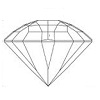16.14: Tourmaline
- Page ID
- 4341
\( \newcommand{\vecs}[1]{\overset { \scriptstyle \rightharpoonup} {\mathbf{#1}} } \)
\( \newcommand{\vecd}[1]{\overset{-\!-\!\rightharpoonup}{\vphantom{a}\smash {#1}}} \)
\( \newcommand{\dsum}{\displaystyle\sum\limits} \)
\( \newcommand{\dint}{\displaystyle\int\limits} \)
\( \newcommand{\dlim}{\displaystyle\lim\limits} \)
\( \newcommand{\id}{\mathrm{id}}\) \( \newcommand{\Span}{\mathrm{span}}\)
( \newcommand{\kernel}{\mathrm{null}\,}\) \( \newcommand{\range}{\mathrm{range}\,}\)
\( \newcommand{\RealPart}{\mathrm{Re}}\) \( \newcommand{\ImaginaryPart}{\mathrm{Im}}\)
\( \newcommand{\Argument}{\mathrm{Arg}}\) \( \newcommand{\norm}[1]{\| #1 \|}\)
\( \newcommand{\inner}[2]{\langle #1, #2 \rangle}\)
\( \newcommand{\Span}{\mathrm{span}}\)
\( \newcommand{\id}{\mathrm{id}}\)
\( \newcommand{\Span}{\mathrm{span}}\)
\( \newcommand{\kernel}{\mathrm{null}\,}\)
\( \newcommand{\range}{\mathrm{range}\,}\)
\( \newcommand{\RealPart}{\mathrm{Re}}\)
\( \newcommand{\ImaginaryPart}{\mathrm{Im}}\)
\( \newcommand{\Argument}{\mathrm{Arg}}\)
\( \newcommand{\norm}[1]{\| #1 \|}\)
\( \newcommand{\inner}[2]{\langle #1, #2 \rangle}\)
\( \newcommand{\Span}{\mathrm{span}}\) \( \newcommand{\AA}{\unicode[.8,0]{x212B}}\)
\( \newcommand{\vectorA}[1]{\vec{#1}} % arrow\)
\( \newcommand{\vectorAt}[1]{\vec{\text{#1}}} % arrow\)
\( \newcommand{\vectorB}[1]{\overset { \scriptstyle \rightharpoonup} {\mathbf{#1}} } \)
\( \newcommand{\vectorC}[1]{\textbf{#1}} \)
\( \newcommand{\vectorD}[1]{\overrightarrow{#1}} \)
\( \newcommand{\vectorDt}[1]{\overrightarrow{\text{#1}}} \)
\( \newcommand{\vectE}[1]{\overset{-\!-\!\rightharpoonup}{\vphantom{a}\smash{\mathbf {#1}}}} \)
\( \newcommand{\vecs}[1]{\overset { \scriptstyle \rightharpoonup} {\mathbf{#1}} } \)
\( \newcommand{\vecd}[1]{\overset{-\!-\!\rightharpoonup}{\vphantom{a}\smash {#1}}} \)
\(\newcommand{\avec}{\mathbf a}\) \(\newcommand{\bvec}{\mathbf b}\) \(\newcommand{\cvec}{\mathbf c}\) \(\newcommand{\dvec}{\mathbf d}\) \(\newcommand{\dtil}{\widetilde{\mathbf d}}\) \(\newcommand{\evec}{\mathbf e}\) \(\newcommand{\fvec}{\mathbf f}\) \(\newcommand{\nvec}{\mathbf n}\) \(\newcommand{\pvec}{\mathbf p}\) \(\newcommand{\qvec}{\mathbf q}\) \(\newcommand{\svec}{\mathbf s}\) \(\newcommand{\tvec}{\mathbf t}\) \(\newcommand{\uvec}{\mathbf u}\) \(\newcommand{\vvec}{\mathbf v}\) \(\newcommand{\wvec}{\mathbf w}\) \(\newcommand{\xvec}{\mathbf x}\) \(\newcommand{\yvec}{\mathbf y}\) \(\newcommand{\zvec}{\mathbf z}\) \(\newcommand{\rvec}{\mathbf r}\) \(\newcommand{\mvec}{\mathbf m}\) \(\newcommand{\zerovec}{\mathbf 0}\) \(\newcommand{\onevec}{\mathbf 1}\) \(\newcommand{\real}{\mathbb R}\) \(\newcommand{\twovec}[2]{\left[\begin{array}{r}#1 \\ #2 \end{array}\right]}\) \(\newcommand{\ctwovec}[2]{\left[\begin{array}{c}#1 \\ #2 \end{array}\right]}\) \(\newcommand{\threevec}[3]{\left[\begin{array}{r}#1 \\ #2 \\ #3 \end{array}\right]}\) \(\newcommand{\cthreevec}[3]{\left[\begin{array}{c}#1 \\ #2 \\ #3 \end{array}\right]}\) \(\newcommand{\fourvec}[4]{\left[\begin{array}{r}#1 \\ #2 \\ #3 \\ #4 \end{array}\right]}\) \(\newcommand{\cfourvec}[4]{\left[\begin{array}{c}#1 \\ #2 \\ #3 \\ #4 \end{array}\right]}\) \(\newcommand{\fivevec}[5]{\left[\begin{array}{r}#1 \\ #2 \\ #3 \\ #4 \\ #5 \\ \end{array}\right]}\) \(\newcommand{\cfivevec}[5]{\left[\begin{array}{c}#1 \\ #2 \\ #3 \\ #4 \\ #5 \\ \end{array}\right]}\) \(\newcommand{\mattwo}[4]{\left[\begin{array}{rr}#1 \amp #2 \\ #3 \amp #4 \\ \end{array}\right]}\) \(\newcommand{\laspan}[1]{\text{Span}\{#1\}}\) \(\newcommand{\bcal}{\cal B}\) \(\newcommand{\ccal}{\cal C}\) \(\newcommand{\scal}{\cal S}\) \(\newcommand{\wcal}{\cal W}\) \(\newcommand{\ecal}{\cal E}\) \(\newcommand{\coords}[2]{\left\{#1\right\}_{#2}}\) \(\newcommand{\gray}[1]{\color{gray}{#1}}\) \(\newcommand{\lgray}[1]{\color{lightgray}{#1}}\) \(\newcommand{\rank}{\operatorname{rank}}\) \(\newcommand{\row}{\text{Row}}\) \(\newcommand{\col}{\text{Col}}\) \(\renewcommand{\row}{\text{Row}}\) \(\newcommand{\nul}{\text{Nul}}\) \(\newcommand{\var}{\text{Var}}\) \(\newcommand{\corr}{\text{corr}}\) \(\newcommand{\len}[1]{\left|#1\right|}\) \(\newcommand{\bbar}{\overline{\bvec}}\) \(\newcommand{\bhat}{\widehat{\bvec}}\) \(\newcommand{\bperp}{\bvec^\perp}\) \(\newcommand{\xhat}{\widehat{\xvec}}\) \(\newcommand{\vhat}{\widehat{\vvec}}\) \(\newcommand{\uhat}{\widehat{\uvec}}\) \(\newcommand{\what}{\widehat{\wvec}}\) \(\newcommand{\Sighat}{\widehat{\Sigma}}\) \(\newcommand{\lt}{<}\) \(\newcommand{\gt}{>}\) \(\newcommand{\amp}{&}\) \(\definecolor{fillinmathshade}{gray}{0.9}\)| Tourmaline | |
|---|---|
| Chemical composition | Complex borosilicate |
| Crystal system | Trigonal |
| Habit | Trigonal prisms with convex faces |
| Fracture | Conchoidal |
| Hardness | 7.5 |
| Optic nature | Uniaxial - |
| Refractive index | 1.62 - 1.64 |
| Birefringence | 0.014-0.021 (up to 0.039) |
| Dispersion | Low, 0.018 |
| Specific gravity | 3.06 (3.01-3.11) |
| Lustre | Vitreous |
| Pleochroism | Weak to strong |

Figure \(\PageIndex{1}\): Bi-color tourmaline
Photo courtesy of Lembeck Gems
| Tourmaline image gallery |
Tourmaline is an extremely complex borosilicate that occurs in more than 100 colors. It is hard and durable and very well suited for jewelry. It is a pyroelectric mineral, meaning that when warmed, it attracts dust and other lightweight particles. The Dutch later noticed this property and called the crystals "aschentreckers," and used them to pull ashes out of tobacco pipes. It wasn't introduced into Europe until the early 1700's, when it was imported from the Ceylon by the Dutch. Shortly thereafter it was declared a stone of the Muses, inspiring and enriching the creative processes. It was a talisman for artists, actors and writers. Today, it is mined extensively in South America, East Africa, and in San Diego County, California.
Tourmaline group
Tourmaline is a large group consisting of complex borosilicates.
Species
Only 5 species of tourmaline are of real importance to gemologists.
- Elbaite
- Elbaite is a, lithium rich, species of the tourmaline group and the name elbaite is named after the island of Elba,Italy.
Most tourmaline gemstone varieties on the market belong to this species.
- Elbaite is a, lithium rich, species of the tourmaline group and the name elbaite is named after the island of Elba,Italy.
- Liddicoatite
- Dravite


Figure \(\PageIndex{2}\): Faceted Dravite Tourmaline
Photo courtesy of The Gem Trader
- Chromdravite
- Schorl
- Schorl is the, iron rich, black variety of the tourmaline group and is used in mourning jewelry.
Its name comes from the old mining expression for 'false one'.
- Schorl is the, iron rich, black variety of the tourmaline group and is used in mourning jewelry.
From the above 5, elbaite is the most important one. Discrimination between elbaite and liddicoatite is usually not attempted.
Varieties
There are many, mainly color, varieties of these species.
Color varieties (names apply to all species).
- Achroite - colorless tourmaline
- Rubellite - red tourmaline (color due to iron and manganese)
- Indicolite - blue tourmaline (color due to iron)
- Verdelite - green tourmaline (color due to iron and titanium)
- Siberite - reddish-violet tourmaline
- Watermelon - a pink core with green edges

Figure \(\PageIndex{3}\): Watermelon Tourmaline Slices
Photo courtesy of Olivier Louy, M.Sc, A.G. (HH)
- Bi-color - two colored tourmaline
- Tri-Color - three colored tourmaline
Other varieties.
- Paraiba - neon colored elbaite tourmaline (color due to copper and manganese)
Diagnostics
Color
Tourmaline occurs in almost any color. Bi-colored specimens and "watermelons" are common.
Refractive index
The refractive index of tourmaline lies between 1.610 and 1.698 (usually between 1.62 and 1.64) with a birefringence up to 0.039 (usually 0.019).
nω = 1.631-1.698, nε = 1.610-1.675, optic sign is negative.
The indices of refraction increase with higher iron content.
Probably due to thermal shock (and/or heat treatment), some stones may show 4 (or even 8) different values per reading. This effect is named the "Kerez effect". Careful recutting of the stone will reveal that it is an outer-edge phenomenon [Dietrich, 1985].
Polariscope
Some dark colored tourmalines have a so-called "closed axis" due to strong selective absorption in the direction of the optic axis and an interference figure may be hard (if not impossible) to find in that case.
Lighter colored stones may be cut with the optic axis perpendicular to the table and good interference figures can be found there.
Some tourmalines show pseudo-biaxial (due to internal stress) interference figures on lateral rotation with a 2V up to 25° [Nesse, 2004; Dietrich, 1985].
Magnification
Tourmalines can be of type I to type III clarity grades.
Typical inclusions are:
- Trichites (small thread-like twists)
- Flattened liquid channels running parallel to the optic axis.
- Liquid Veils
- 2 and 3-Phase Inclusions
- Hollow tubes

Figure \(\PageIndex{4}\): Tourmaline with liquid veils, hollow tubes and phase inclusions
40X Magnification
by Barbra Voltaire

Figure \(\PageIndex{5}\): Tourmaline filled with negative crystals, oriented in random directions
80X Magnification
by Barbra Voltaire

Figure \(\PageIndex{6}\): Growth Tubes in Pink Tourmaline
~75X Magnification
by Jamey Swisher

Figure \(\PageIndex{7}\): Ends of Growth Tubes in Pink Tourmaline
~75X Magnification
by Jamey Swisher
Phenomena
- Cat's-eyes
- Color Change
An Unusual Variety of Color Change Elbaite ("Laurellite")
A variety of color change tourmaline has been collected and described by Bruce A. Fry.

Figure \(\PageIndex{8}\): Color Change Tourmaline
Courtesy of Bruce Fry
Treatments
Tourmalines may be heat treated to around 700° C to lighten the color, this is a stable alteration.
A process which seems to work well for deep saturated reds from Nigeria involves slowly ramping the furnace at a rate of 125° C per hour to 520° C, holding the latter temperature for 2 hours and then letting the furnace cool completely.
A deep red Nigerian stone in the gallery below has been heat-treated several times as an experiment by Roger Dery with the ramping done last (following instructions by Lisa Elser on the latter part).

Figure \(\PageIndex{9}\): Nigerian red tourmaline. Heat treated at 360° C for 2 hours

Figure \(\PageIndex{10}\): Heat treated at 410° C for 2 hours (same stone)

Figure \(\PageIndex{11}\): Ramped up to 520° C over a three hour period. Held at 520° C for two hours, followed by cooling (same stone)
Other treatments are irradiation - for example with cobalt-60 - (stable) and waxing of surface imperfections. The latter treatment is not stable.
Cobalt-60 gamma irradiation gives rise to pink and hot pink colors in some tourmaline.
Gallery of Tourmaline Crystals from Paraiba, Brazil
The following crystals were collected by Jason Barrett.
All specimens are from Sao Jose da Batalha mine in Paraiba State, Brazil.
Not all tourmalines from this mine were copper-bearing and these specimens have not been tested for copper content.

Figure \(\PageIndex{12}\): Crystal #1
Weight: 88.4 grams
Measurements:5cm x 4cm x 3cm

Figure \(\PageIndex{13}\): Crystal #1
Weight: 88.4 grams
Measurements:5cm x 4cm x 3cm

Figure \(\PageIndex{14}\): Crystal #2
Weight: 314.1 grams
Measurements:7cm x 5.5cm x 4.5cm

Figure \(\PageIndex{15}\): Crystal #2
Weight: 314.1 grams
Measurements:7cm x 5.5cm x 4.5cm

Figure \(\PageIndex{16}\): Crystal #3
Weight: 268.8 grams
Measurements:10cm x 6cm x 4.5cm

Figure \(\PageIndex{17}\): Crystal #3
Weight: 268.8 grams
Measurements:10cm x 6cm x 4.5cm

Figure \(\PageIndex{18}\): Crystal #3
Weight: 268.8 grams
Measurements:10cm x 6cm x 4.5cm

Figure \(\PageIndex{19}\): Crystal #4
Weight: 81.8 grams
Measurements:7cm x 4cm x 3cm

Figure \(\PageIndex{20}\): Crystal #4
Weight: 81.8 grams
Measurements:7cm x 4cm x 3cm

Figure \(\PageIndex{21}\): Crystal #5
Weight: 18.9 grams
Measurements:4.5cm x 2cm x 1cm

Figure \(\PageIndex{22}\): Crystal #5
Weight: 18.9 grams
Measurements:4.5cm x 2cm x 1cm

Figure \(\PageIndex{23}\): Crystal #6
Weight: 3.0 grams
Measurements:2cm x 1.5cm x 0.5cm

Figure \(\PageIndex{24}\): Crystal #6
Weight: 3.0 grams
Measurements:2cm x 1.5cm x 0.5cm

Figure \(\PageIndex{25}\): Crystal #7
Weight: 24.4 grams
Measurements:3cm x 3.5cm x 2.5cm

Figure \(\PageIndex{26}\): Crystal #7
Weight: 24.4 grams
Measurements:3cm x 3.5cm x 2.5cm

Figure \(\PageIndex{27}\): Crystal #8
Weight: 52.9 grams
Measurements:5.5cm x 3.5cm x 2.5cm

Figure \(\PageIndex{28}\): Crystal #8
Weight: 52.9 grams
Measurements:5.5cm x 3.5cm x 2.5cm

Figure \(\PageIndex{29}\): Crystal #9
Weight: 54.8 grams
Measurements:7cm x 4cm x 1.5cm

Figure \(\PageIndex{30}\): Crystal #9
Weight: 54.8 grams
Measurements:7cm x 4cm x 1.5cm

Figure \(\PageIndex{31}\): Parcel of Tourmaline
Courtesy Jason Barrett
The parcel above was submitted by Jason Barrett for a microprobe analysis by UNO and the MP2 research group.
The results are as follows:
SiO2:36.712%
Al2O3:42.221%
MnO:1.56%
CuO:1.471%
FeO:0.022%
MgO:0.000%
Na2O:2.365:
K2O:0.022%
F:1.182%
The 1.471 wt. % of CuO is just right in the range for the true Paraiba (Brazil) material
Sources
- Gems Their Sources, Descriptions and Identification 4th Edition (1990) - Robert Webster (6th ed.)
- The Tourmaline Group (1985) - Richard Dietrich ISBN 0442218575
- Introduction to Optical Mineralogy 3rd edition (2003), Prof. W.D. Nesse
- Refraction Anomalies in Tourmalines - R. Keith Mitchell, Journal of Gemmology Vol. 10, 194 (1967)
- Red/Pink Tourmaline heat treatment
- Embrarad


